[leadplayer_vid id="58D819C88D1E0"]
You can find more photos and details about this property by clicking here.
In the video, I mention a few links you may want to click. Here they are:
Hi, this is Betsy of Living in Panama.
About the Property
We have a wonderful beachfront lot for sale in the charming beach town of Puerto Armuelles
This property has everything going for it:
Also For Sale
The 2 adjacent properties you see are also for sale, -- which includes the yellow beachfront house we are currently remodelling. To find out more, click the link below
As I said, this property is in Puerto Armuelles, in the Chiriqui province.
Here we are getting closer; to get a Google Earth view of the property.
Price
It is only $54,500 dollars.
Near Services
This beachfront property is in a great location. Just a block and a half from the Tsunami Inn which hosts a horseshoe game and expat hang out event every Sunday afternoon.
Even closer, in the other direction, are 2 restaurants. Las Juanas which is a seafood restaurant with outdoor seating right on the beach. It is really a great place to hang out.
Next to it is Big Daddy's Hotel, which has a restaurant inside, with air-conditioning.
There are a couple of small grocery stores within a block or two of the property. Puerto also has a great Romero grocery store as well as others about 5 minutes away.
Nearby Things To Do
This property and Puerto Armuelles, in general, can take advantage of all that Chiriqui Province offers.
It is only an hour day trip down to visit Mono Feliz and maybe feed the monkeys.
You can take a swim in front of your property in the morning and then go take a hike in Volcan or Boquete or Cerro Punta and be back at your beachfront home after a leisurely day.
David is about an hour and 15 minutes away. Its the biggest town in Chiriqui, Puerto Armuelles is the 2nd biggest, but David is definitely the shopping mecca. You can get pretty much you’d ever want there. And it keeps growing in that way. (e.g., a huge expansion of the Chiriqui Mall in David is currently underway)
And even outside of the Chiriqui province you can go along up this way to Almirante and take the ferry to Bocas del Toro for maybe a long weekend.
Or you can go right over here and visit Costa Rica.
About Puerto Armuelles
Or you could simply hang out in Puerto Armuelles.
Chiquita banana built Puerto Armuelles from scratch starting in the late 1920s. They put a unique stamp on this charming beach town. Including building whole neighborhoods of wooden houses on stilts.
Today Puerto is a charming beach town.
In fact, it is the only true beach town in Panama.
It has pretty much everything you need to live comfortably, including a great beach life, whether for you that is walking on the beach, boogie boarding, stand up paddleboarding, or surfing, or going there to buy fish from the fishermen.
More Info
For more information on this property, please contact us at our site, LivinginPanama.com or click the link below.
Please give us a thumbs up if you enjoyed this video and don’t forget to subscribe (YouTube).
You can explore more properties in Puerto Armuelles here.
And you can learn more about our charming beach town starting here.
Updated: March 24, 2017
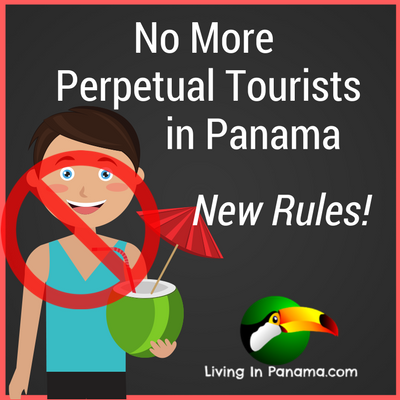
As of March 6th, you cannot renew your Panama Tourist Visa, unless you leave Panama for at least 30 days.
That's right you must leave for 30 days.
Don't worry, you are exempt if your residency visa application is being processed.
However, for those applying for residency, make sure you are given an ID showing that your residency is in process. Without that ID you need to comply with the new Tourist Visa regulations.
It is the steadily increasing number of people working on a perpetually renewed tourist visa that sparked the uproar.
I don't think the changes are prompted by North Americans doing this. In my opinion, it is the perpetual "tourists" from other latin american countries that caused this massive rule changes. (The government has also changed some work permit rules.)
When I was in Panama City last month, most of the waiters I talked to were from Nicaragua or Colombia. I was told that the authorities have been increasingly making surprise visits to businesses and asking to see all the workers work permit documents. The large number of illegal workers has been a growing government concern.
Given that Venezuelans were the primary subject of most of the initial border crossing stories there may even be more Venezuelans than other nationalities working illegally in Panama. But whether that is true or not, the new rules are apply to all tourists, regardless of their country of origin.
In general, Panama is very protective of jobs for Panamanians. For instance, there are 25 categories of jobs that foreigners are forbidden to hold by Panamanian law. It is also why they have also recently changed how easy it is to get a work permit for friendly nation visa holders.
So it is not surprising they are coming down hard.
There are increasing numbers of people working in Panama, illegally, on a tourist visa.
Need a residency visa? Here are 4 Panama visas you may qualify for.
Even before this rule change there was a number of reasons to get residency in Panama.
90 vs 180 Day Tourist Visa
For citizens of some countries, Panama will now only issue a 90 day tourist visa. It was President Varella's predecessor, President Martinelli, who lengthened it to 180 days.
In Varella's Executive Decree No. 590 he shortened it back to the 90 day tourist visa.
However, in Decree No. 591, of the same day, Varella made an exception to the 90 day tourist visa for citizens of countries which are not required to get a tourist visa BEFORE they arrive in Panama.
Therefore, citizens of the US, UK, Canada, Australia, and many other countries will be issued an 180 day tourist visa. This page of wikipedia has a list of all the countries which are not required to have a visa to visit Panama. If you hold a passport from any of those countries, you will be issued a 180 day tourist visa in Panama.
(Note: you can only legally drive a vehicle for first 90 days on a tourist visa, even if you have a 180 day visa.)
30 Day Exit
The biggest change to the tourist visa is its renewal policy.
Now, to renew a tourist visa (both 90 and 180 day visas) tourists are required to leave Panama for a minimum of 30 days before reentering Panama.
Legal Residents & Applicants
If you are a foreigner (e.g., American, Canadian...) with legal Panamanian residency this does not impact you. A foreigner with legal residency in Panama is not required to stay outside the country x number of days before being allowed to re-enter.
Again, if you have applied for your residency visa, but don't have it yet, you should receive an ID showing that your residency is in process. If you have that ID, you are also not required to stay outside the country x number of days before being allowed to re-enter. (Note, if you don’t have this ID, then you should leave Panama before your tourist visa ends.)
Keep in mind, that the officials at the border crossing don't always understand the rule changes themselves. Always be polite and gracious. If you need to, simply ask to see their manager.
Here is the email that the American Citizen Services department of the US Embassy in Panama sent out about these changes.
The U.S. Embassy in Panama would like to inform all U.S. Citizens in Panama that on March 6th 2017, the Panamanian Immigration Authority (Servicio Nacional de Migracion-SNM) announced new guidance for Panamanian immigration officials on the enforcement of pre-existing regulations.
According to the SNM, immigration officials have been instructed to be stricter about the enforcement of the regulation that foreigners entering Panama with tourist status prove that they are in fact entering Panama as tourists and not residing in Panama.
Since the announcement, the Consular Section has received many questions from U.S. citizens about this new guidance.
Below are the most frequently asked questions along with the responses the Consular Section received from the SNM.
Should you have further questions, please reach out to the SNM directly via phone at507-1800 or visit their website at: http://www.migracion.gob.pa
In order to re-enter Panama on tourist status, does a U.S. Citizen need to return to their country of origin (the country from which they came into Panama) or can they return from a third-country (example: Costa Rica)?
Answer: In the new guidance SNM does not specify if the tourist needs to return his/her country of origin. What is being implemented is that, in most cases, the person needs to leave Panama for a minimum of 30 days before reentering as a tourist.
In order for a person to re-enter Panama on tourist status, what is the minimum amount of time the person needs to spend outside of Panama?
Answer: The new requirement that is being implemented by SNM in reference to time spent out of Panama is a minimum of 30 days before applying for admission, in most cases.
In order for a person to re-enter Panama on mariner visa status, what is the minimum amount of time the person needs to spend outside of Panama.
Answer: According to SNM, mariner visas are valid for 90 days and must be renewed on the 90th day, or the day before, from the date of the previous mariner visa stamp. Mariner visas can only be renewed once before the visa- holder needs to exit Panama. The amount of time the person with the mariner visa needs to stay outside of Panama is not specified by SNM.
If entering Panama on tourist status, does the method of entry need to match the method of exit (i.e. can a U.S. Citizen enter Panama on a plane and use as proof of exit evidence that they own a boat in Panama and plan to exit via boat)?
Answer: The method of entry and exit into and out of Panama does not have to be the same so long as the entries and departures are met legally by using established Ports of Entry – land, maritime or air and admitted by a Panamanian immigration officer.
Do U.S. Citizens with legal Panamanian residency status also require a roundtrip ticket when entering Panama?
Answer: No. A foreigner with legal residence in Panama does not need to show proof of exit from Panama.
Is a person applying for Panamanian residency required to stay in Panama for the entire duration of time required to complete the residency process? If so, what happens if the process takes more than the allotted six months for tourist status.
Answer: If the person has an ID that shows that his/her residency is in process, the person is fine to leave and return to Panama. If there is no ID, then the person should exit as a tourist (i.e., before the sixth month approaches).
How long does the FBI Identification Record process, required for purposes of obtaining residency in Panama, take? Can this process be expedited?
Answer: For information on the FBI identification record process, individuals may visit https://www.fbi.gov/services/cjis/identity-history-summary-checks. According to the FBI website, the current turnaround estimate for these records is 12 to 14 weeks plus the amount of time the results may take to arrive in the mail. Currently there is no option to receive the response electronically. For questions on this topic, individuals may call (304) 625-5590 or write an email to [email protected]
Tourists are only allowed to drive in Panama for 90 days. Is there an exception for this given that tourists are allowed to stay in Panama for 180 days?
Answer: According to the Transit authority (http://www.transito.gob.pa/sites/default/files/reglamento_decreto_640..pdf) foreigners that enter Panama as tourists are not permitted to obtain Panamanian drivers’ licenses and are only allowed to drive with a foreign license for 90 days. There are no exceptions to this rule.
Can SNM waive the FBI Identification Record process if a person does not exit Panama for two years? If so, would there be an exception to the 180 day stay limit for tourists for a person trying to obtain this waiver?
Answer: If a person stays in Panama for more than two years then the FBI requirement does not apply. The waiver of the FBI requirement applies to those people that stay in Panama two years, without exiting. In these cases, a fine is paid by the person for overstaying their tourist visa and the person is only required to present a PNM police record rather than the FBI check.
You can find all the decrees and laws that affect immigration at Panama's department of immigration (Servicio Nacional de Migración de Panamá or SNM). You can visit their website or call them at 507 1807 or 507-1822.
Do you want to live long term in Panama?
Explore out our affordable Puerto Armuelles real estate.
[leadplayer_vid id="58B33CE6847AD"]
We had fun, and bought a couple of different kinds of fish. Although, we were hoping to find a tuna that day, but no luck.
We love tuna, but it isn't popular here. Which is great for us. It is not popular so they sell it for only 60 cents a pound. Lightly seared and served with wasabi it is delectable.
Maybe next time they will have some tuna.
Where do you buy your fish in Panama?
We like to buy it off the boats. But people will walk or bike around with fish for sale.
We are alittle leary of buying non-iced seafood.
But if you go that route, here is a video that explains how to tell if a fish is fresh.
It is done by one of the YouTubers my daughter Blaise likes, Bart's Fish Tales. He also has alot of receipes for seafood of all sorts.
[leadplayer_vid id="58B33FE64858B"]
Please comment below

David is also conveniently located for day trips to visit Puerto Armuelles, Boquete, Volcan or Boca Chica, etc.
Sometimes even if you live in Chiriqui, you may want to stay the night in David. Those of us who live in Chiriqui, will go to David for all those items you cannot find anywhere else. Often, all those saved up errands turns into a very long day.
For example, if you are like us, you don’t drive to David very often. When we are in Seattle, we can run most of our errands in our own neighborhood. We don’t drive very much. Or, when we do drive, we take very short trips. We live a similar lifestyle in Puerto Armuelles. We can find almost everything we need, throughout the year, in Puerto. Everything from a very good grocery store, fresh fish and produce direct from the fisherman, or the farmer, to at least a half dozen building supply stores, to printing, copying, office supplies, etc.
We only go to David for things for some meetings or we sometimes need to buy parts for one of our cars that are not available at the frontera (Paso Canoas). There are also oversized (Architectural blueprint size) printers available in David. Full size plan sets are required for building permits in Panama.
There are 2 places to get oversized copies. Oficentro, a block east of the Central Park or Librereria Daisy, about two blocks north of Oficentro. (We are big fans of Oficentro. It sells a big assortment of art supplies, office supplies, jewelry, hair accessories and more.)
One of our David errands is PriceSmart. PriceSmart is Panama’s Costco.
We go there for various items, such as huge bag of dog food, Ghirardelli brownie mixes, frozen pizza, printer ink, Serrano ham, fresh mozzarella cheese, and more. When we go to PriceSmart, particularly if we are hungry and tired at the end of the day of errand running, we often come home with things that we really didn’t need. This is especially true because our family of 4 is more of cranky shopping committee at the end of a David trip, than a focused couple or single shopper.
PriceSmart is located on the highway Inter-Americana, 2 of kilometers south of the central part of David.
Occasionally, we have decided to spend the night in David after a long day of errands.
When we do our PriceSmart shopping trip that next morning we find we both don’t buy too much and don’t forget crucial items. The savings we gain from not over-shopping at Price Smart after a overly long day in David covers our hotel stay. So, a simple overnight stay in David can be good for family relations, even for one’s marriage. Amazing!
Plus you may find yourself needing to stay over night, or driving back the next day. Sometimes a meeting with a lawyer or notary in David, proves to be a 2-day thing.
The papers that were supposed to be available for signing quickly are not available. Or, the person running the agency where the papers are needed, suddenly remembers that there is one more “critical” document that needs to be signed in triplicate in order for a certain legal, bureaucratic process to move forward.
“Don’t worry: I’ll have the papers ready for you first thing in the morning”, says the smiling notary, or secretary, lawyer, etc.
We have all heard this on more than one occasion.
For those of us, who do not like to drive, the idea of driving all the way back home to Puerto Armuelles (1-1/4 hours, one way) only to turn around and do the trip again the very next morning, is well worth the $50, or $60 for a comfortable hotel. (Puerto Del Sol is an affordable & comfortable hotel in David)
The small capital city of our province does not provide much of an attraction for those of us living elsewhere in Chiriqui. However, it is occasionally necessary to make the trip to David.
By taking an extra half day to complete all of our tasks in David, we find we are much less stressed and tired. The trip is then even be enjoyable, or at least comfortable.
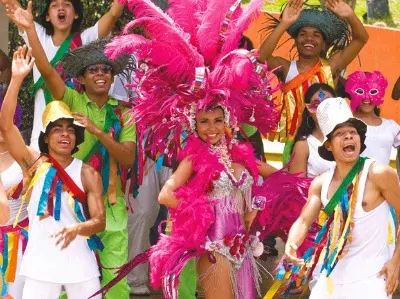
I mention which towns embrace Carnival later in this post.
Carnival festivities include both traditional Spanish & Panamanian features.
The Carnival festivities start in the morning hours in the central plaza or other open area. A popular feature are cistern trucks (culecos) that water-hose (mojadera) people for a few hours, along with loud music, entertainment, and lots of beer and seca.
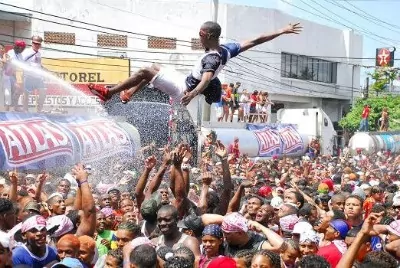
La mojadera is a popular, fun, and wet Carnaval tradition in Panama. La mojadera is a spray of water meant to soak you. Its creation was obviously inspired by the hot tropical weather. We enjoyed being hosed down from a culecos in Chitre when we were there for Carnival years ago.
February and March, when Carnival happens, are the hottest months of the year in Panama. Typically, the cooler highlands of Panama don't celebrate Carnival as much and when they do, la mojaderas are not part of the celebrations.
You will find these culecos cruising the parade route, or you may get sprayed by an enthusiastic Carnival-goer wielding a water balloon, water gun, or a bucket.
Obviously, you should be prepared to get wet - both mentally and your choice of clothing. However, you can usually avoid a spray from a culecos if you pay attention. Of course, you most likely will welcome a good dousing.
There is a lot of dancing, jumping, popular music, people in bathing suits, contests, and more. This goes on until the early hours of the afternoon.
Then everyone goes home to rest and prepare for the parade and the real partying. Panamanians typically start partying late and go til the wee hours.

In the evening, the parade starts. The parades typically feature floats ("topones"), bands of mostly trumpets and drums ("tunas") and, of course, the Carnival Queen and her court in elaborate costumes.
The parades have a different theme each night.
You will find plenty of food to buy at street stands, and of course beer and other alcoholic beverages.
Just before sunrise on Ash Wednesday, the Carnival queen leads the last parade, a funeral procession. It is known as the Burial of the Sardine ("Entierro de la Sardina")
A symbolic sardine is carried in a tiny coffin by costumed mourners to its burial spot. This burial tradition is an import from Spain.
The act signifies the end of the partying and the beginning of the 40 days of Lent.
The majority of Panamanians are Catholics. Ash Wednesday is the first day of Lent. In Catholicism, Lent represents the 40 days that Jesus prayed and fasted in the desert before he returned to Jerusalem (Palm Sunday). 5 days later he was crucified (Good Friday). Then 3 days after that, he rose from dead (Easter).
El Entierro de la Sardina attracts large crowds that stay up all night to see Carnival to its customary close, which typically involves alot of fireworks.
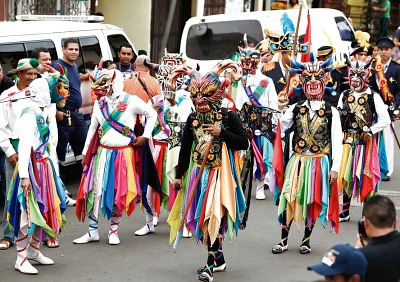
Carnavales is mostly celebrated in
I have some information about the celebrations in both Las Tables and Panama City below. But first a word about Carnival in my province of Chiriqui.

I only know of 3 carnival celebrations in Chiriqui: Dolega, David, and Las Lajas.
Until last year, David hadn't celebrated Carnival for 16 years. Supposedly it was for unspecified security reasons. Now they do celebrate Carnival, but not after dark. The festivities are scheduled to end at 7pm, every night but Friday. Friday night will feature a big parade highlighting the Carnival queen.
From what I hear, even though it is late to the game, David's Carnival is by far the best of the 3.
Here in Puerto Armuelles, people typically head out to the beach on Punta Burica or have a BBQ at home. There may be a bull-fight ("barrera").
Note: Panama bull-fights aren't anything like a bull-fight in Spain or Mexico. The only good thing you can say about them is that no bull or cow is killed. The increasingly drunk "fighters" are more likely to get hurt than the reluctant-to-participate cows or bulls.
And of course, the bars will be open for business. The bigger bars like TisaMar will have music and charge admission. But generally it is a family holiday.
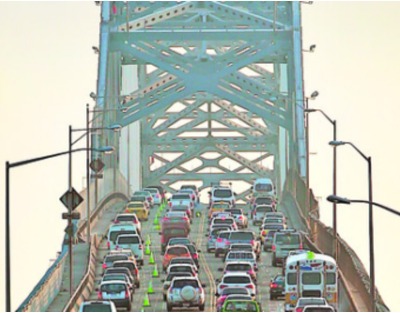
Most people leave Panama City for Carnival.
This is true for almost every holiday in Panama. People leave in order to back home to celebrate with their families back "home".
To give you an idea of the magnitude of the exit, a special carnival task force converted the Bridge of the Americas into a one way road out of Panama City starting at 4pm on Friday until at least 7 pm, with the potential to extend it til later. (see photo).
The plan also calls for an extra lane to be established into the interior.
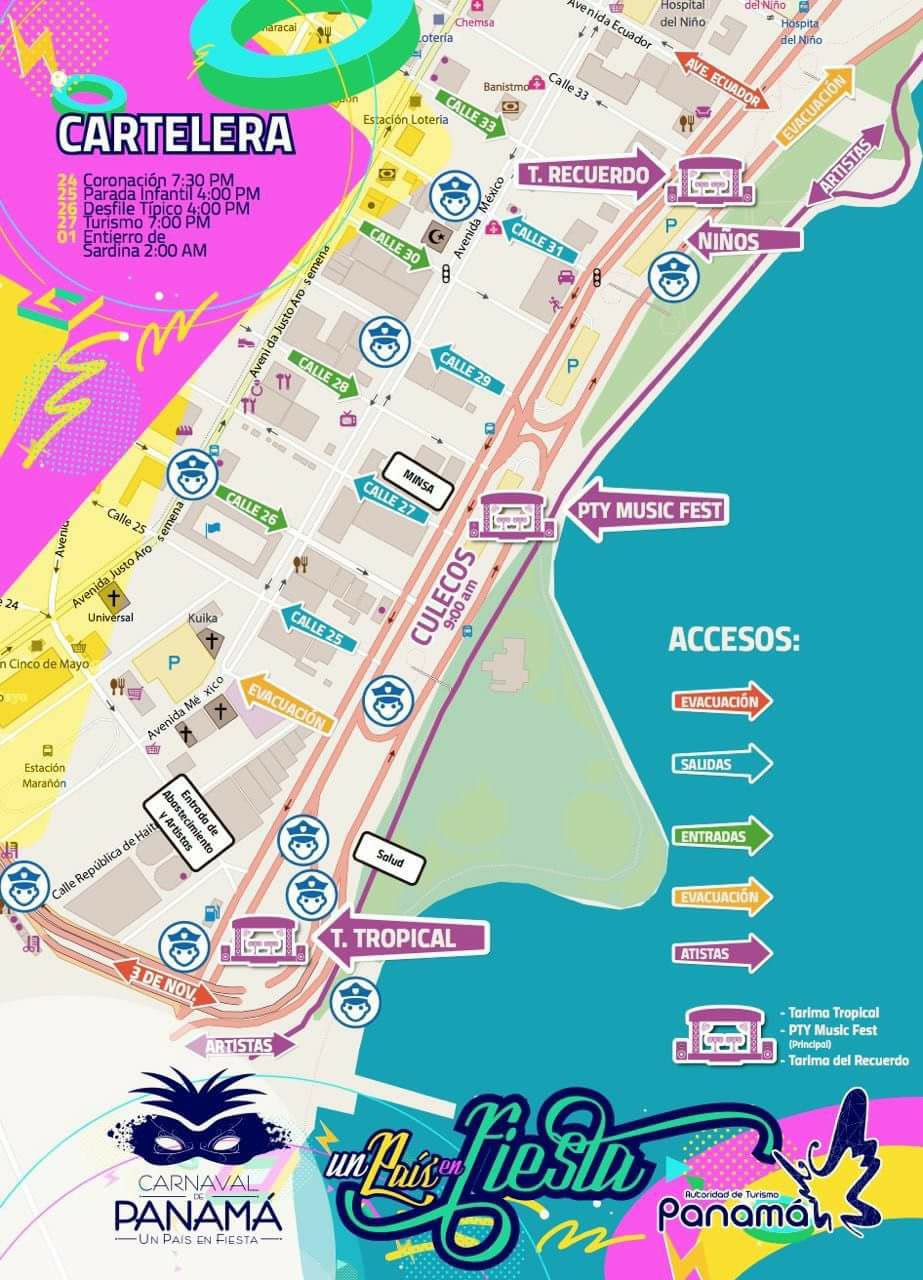
In recent years, there has been a big increase in Carnival celebrations in Panama City. The government has put millions into this effort.
The parade route starts on Via Espana and then goes along the Bay of Panama known as Cinta Costera.
You will enjoy parades with the Carnival Queen and her court, floats, huge crowds and lively bands playing Panamanian folk music, salsa, merengue, reggae, and Caribbean-influenced, exuberant dance music. On Sunday afternoon there is the “pollera” parade, which features women and young girls dressed in the distinctive Panamanian national costume.
For the first few nights, evening partying takes place in clubs, bars and hotels. On Tuesday in particular, there is an extravagant parade with with ornate floats and partying that continues until nearly dawn. (see map image for events)
The small town of Las Tablas on the Azureo Pennisula is the is famed for its Carnival. If you want the most extreme carnival experience in Panama, you must go to Las Tablas.
Plan Ahead
You need to reserve your hotel a year ahead of time. Otherwise, you can do it as day trip from Santiago or Panama City. You can also catch a flight from Panama City to either Chitre or Pedasi and then catch a bus or taxi to the festivities. Las Tablas is about 4 hours from Panama City.
The Feud
Las Tablas carival features an ancient “feud” between Calle Arriba (“Upper Street”), the La Placita neighborhood, and Calle Abajo (“Lower Street”), the Punta Fogón area of town. Each group of residents competes to produce the most beautiful Carnival queen and the most elaborate and awe-inspiring floats. The competition is taken very seriously.
The Video
To better understand the Carnival in Las Tablas, including the feud and the intense year-long preparations, watch the video below. It is an excellent video done by Don Usher.
[leadplayer_vid id="58B07E7BA4A3F"]
We are not much for Carnival ourselves. I do like the la mojadera and I enjoy seeing the more elaborate floats. However, I am happier missing the whole thing.
But if you want to immerse yourself in the celebrations, get ready for a 4 day ride.
Lent starts on Friday with the coronation of the Carnival Queen and her attendants by last year's Queen. Then continues on til the early morning of Wednesday. The biggest celebration is on Tuesday, known as Fat or Shrove Tuesday.
This year, 2017, Carnival starts on Friday, Feb. 24th, and ends in the early morning hours of Wednesday, March 1. In 2018, Carnival will start on Friday, Feb. 9th 'til Wednesday, Feb. 1.
Happy Carnival!
Please share your carnival experiences in Panama. Comment below.
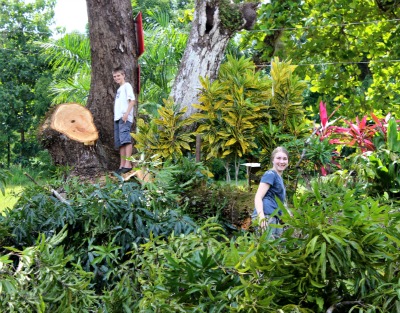
If you are Panamanian, you are much more likely to get away with it. Well, unless you have a neighbor who doesn't like you, or if the tree cutting damages your neighbor’s property.
It is the law.
Expats are expected to, and should, follow the letter of the law here. It is a sign of respect. A neighbor, or even a passerby, is much more likely to turn an expat into the authorities, than a local. Mostly, because it does seem disrespectful for foreigners not to follow the law.
You really do not want to gain a reputation for being someone who doesn’t respect the laws of your new country. It is a reputation that will only make your life more difficult.
Trees are considered a valuable resource in Panama. They are used for buildings and furniture. Their fruit and nuts are a valuable commodity as well.
And the reality is that deforestation is a real problem here. The climate of the Azuero Peninsula radically changed after they cut down most of their trees to expand cow farming. While your back yard trees are not part of the deforestation issue, the regulations to protect Panama's forests and tree resources, include you and your trees.
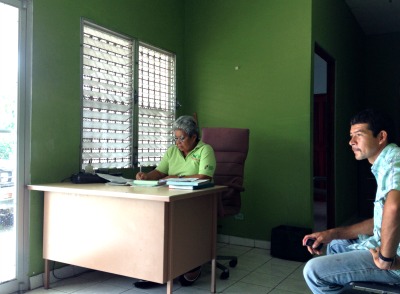
Panamanian law states that you must get a permit to:
You can request both permits at the same time.
You can be fined, if you cut down a tree without a permit. The more trees you cut down, the more you will be fined. Of course, someone has to complain for you to be fined.
The threat of fines does seem to keep people from harvesting trees for money, at least in areas where they are not likely to be seen felling a tree.
An Illegal Tree Cutting Experience. We had a neighbor, an expat, of one of our properties cut down 200 of our trees! The trees were all over 4" in diameter. We had planted them to block the sight of his cell tower. Unfortunately for him, the tees also blocked his ocean view.
While we were out of the country, without attempting to contact us, he decided to cut them all down. When we asked him about it, he claimed that his gardener said, "it was okay to cut them down". Yeah, it was the gardener's fault.
Although, we had ANAM come out and verify the number and size of the trees that he cut down, we did not press any charges. Given the number of trees, the fine would have been quite substantial. While were miffed and mystified about the incidence, but trees are easily grown here. So we decided to let it go. We simply replanted.
We have cut down a few trees in Panama over the years. Usually because the tree was in some way hazardous. For instance, when coconut palm trees get over a certain height, they are dangerous. A coconut falling from up high can kill someone.
Of course, we have also planted over ten thousand trees. We love both the ease of growing as well as the variety of trees here. We usually plant trees for shade, architectural interest, property boundaries, as well as fruit trees for their fruit.
Getting a tree removal permit is:
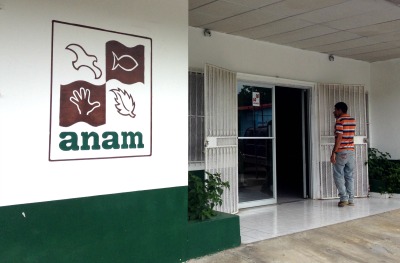
Required Documents
You must submit the following documents to your local ANAM office.
We typically ask our tree cutter to take his aserrador’s (logger) license to the ANAM (Environmental and Marine Administration) office to apply for the permits. We give him all the required documents above. It is much easier that way, as we discuss later in this post
You can apply for up to 5 trees to be removed per permit request.
ANAM in Puerto Armuelles: The ANAM office in Puerto Armuelles (see photo above) is 1 block south of the baseball stadium in Rio Mar neighborhood (on the same street as Pizza Pilo).
In addition, once you (or your tree removal guy) hands over all the required paperwork, you need to formally request an inspection of the property by an ANAM engineer.
The engineer usually comes out to visit the site very quickly: That day or the next. Then he returns to his office, fills out, signs, and stamps the permit.
So far, we have never had any request to fell trees on our property denied.
The property owner then goes to the ANAM office and pays the $13 permit fee. Make sure you leave with the permit in hand.
You then should give the permit to the person who is actually cutting down the tree.
Panamanian law requires that the tree felling permit be in the hands of the tree cutter, just in case of a surprise site inspection.
However, we have never had a follow up inspection in over 10 years of living in Puerto.
The whole process sounds arduous. In reality it is not.
Generally, this entire process can be accomplished in a day or two.
We have obtained our own permits many times.
We used to go to the office ourselves (well, Reyn usually went). Then it did feel arduous.
We find that having the guy who wants to do the tree removal (this applies to all kinds of contracts and contractors) apply for the permit himself, speeds the process up.
The worker knows the engineer. The engineer knows that the worker needs the work to feed his family. It makes it much less likely that there will be any bumps along the way. It is a “done deal”.
Of course, when we did it ourselves we never had a problem, though it did seem to take more time to get the permit. We don't want to discourage you from getting your own permits, but it is something to consider.
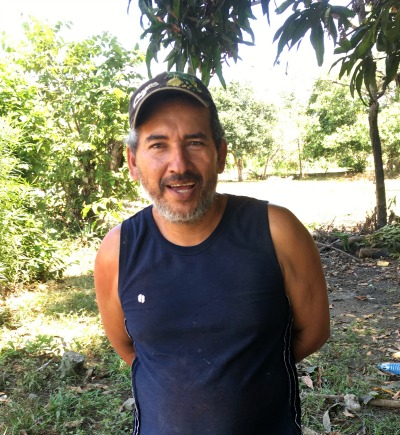
Our Tree Removal Guy - Lalo
Typically, we have Jose “Lalo” Samudio get the tree removal permit for us.
Lalo is a logger/tree remover here in Puerto Armuelles. Lalo is a licensed logger (“aserrador”). He also owns a tractor which is very helpful in the tree removal biz.
Lalo is also a competent woodworker, logger, backyard mechanic, and jack-of-all-trades. In short, Lalo is very handy guy to know. Plus, he has a lovely family, with a wife and three children.
In case you want to hire him, Lalo lives on a corner lot in the Coronado neighborhood, which is just north of the Corazon de Jesus neighborhood. Ask around and someone will point out his house.
Getting a permit will cost you $13 and about 2 days of waiting.
Most importantly, it helps you maintain good relations with both your neighbors and local officials.
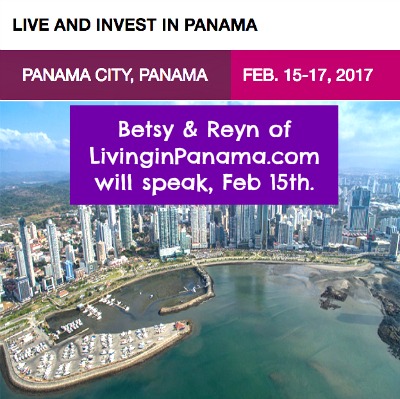
So, on Feb. 15, Reyn and I will share why and how we decided to live in Panama.
And, most importantly, what it is really like to live here in Panama.
The Live and Invest Overseas (LIO) literature about the conference is a bit over the top.
But it looks like the hype could be limited to getting people to attend the conference.
They even magnify the benefits of the accommodations. For instance, in their conference sales page, they state you save money because their special hotel rate includes free breakfast and free wifi. They assert "Internet alone can cost you US$30 a day at some hotels!" However, I have stayed in Panama City countless times and have never been charged for wifi, and almost always breakfast is included in my stay. You can see their sales page here.
However, in no way has LIO asked us to sugar coat or hype our presentation. They simply asked us to share what we would typically share about living in Panama.
So that is our plan. Our talk will be the straight scoop on our experiences moving to and living in Panama.
If possible I will tape our presentation and share it with you, our readers.
Our plan is to attend most, if not all, of the conference.
Neither of us have ever been to an event like this. I am very curious about what is presented and whether it seems realistic. Also, we want to be around to answer attendees questions.
I will write about our impressions when we return.
Although, we have never been to a LIO (or any) Panama conference, we have been in communication with them.
Back in 2013, 2 young men from Live and Invest Overseas came to do a report on our town, Puerto Armuelles. You can read about Live and Invest Overseas' visit to Puerto Armuelles, Panama.
Also, Reyn and I once interviewed Lief Simon of LIO via Skype about his Panama experiences. We put together a video in which he talks about the cost of living in Panama.
Have you been to a conference like this one before?
What was your experience? would you recommend it to a friend?
Please share in the comments below.
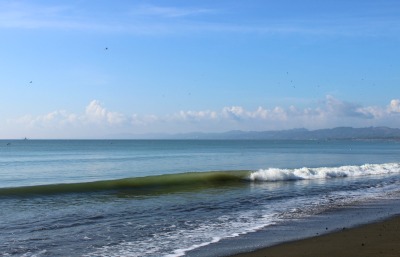
Jan. 26, 2017
On my very first morning, I went to the beach at Corazon de Jesus on for a swim.
I had been told that the November rains were heavy this year and that there was still a lot of drift wood on the beach. However, to my eyes it looked pristine and beautiful.
I had been away for over three months this trip. I had been spending my days in a very cold, grey, and rainy Seattle, so I was not aware of anything other than a perfect morning at the beach.
I was the only one out. The gentle curve of the beach was an empty crescent. Just the sand, nearly mirror flat, the early morning ocean, and I.
I took a short swim, which was plenty. (Note to self: I am really out of shape). But, man did I feel wonderful! The water was probably a warm 80 degrees, or so.
After swimming, I decided to go visit some of my neighbors on the beach.
There are several ex-pat residents in the Corazon de Jesus neighborhood. I was especially interested in talking to a couple of these folks who are doing construction on their homes using local contractors.
I enjoyed hearing about their experiences with the various contractors and sub-contractors. I will write about what I learned in a future post.
In the few days I've been back in Puerto Armuelles, I am noticed a number of new northern faces.
One woman, who had just ended a Panama relocation tour, made a special visit to Puerto. She said that she heard about Puerto Armuelles on our site, and wanted to check out for herself.
She says that she has "caught the Puerto bug". We’ll see if she decides to join us in Puerto soon.
Several of our visitors have visited Puerto more than once to “check it out” and are now expressing interest in buying. Most of our recent buyers are either from Canada or from northerly parts of the US.
A few folks have decided to rent homes in Puerto, rather than buying. Hopefully more rentals will continue to come on the market to meet this growing need for long-term rentals.
Some big news is that Del Monte may finally be coming to Puerto to start up banana production this June 2017. At least this is what the news media here tell us.
My most skeptical Panamanian neighbors here say they will only believe Del Monte is coming when they have peeled and eaten a Del Monte banana that was grown in the soils of Puerto Armuelles.
We all hope Del Monte really does come to Puerto. The town will benefit from the mostly working class jobs that Del Monte will provide.
However, as far as the arrival of ex-pats and any tourist industry here are concerned, I do not think that Del Monte will have much effect. I believe we have passed the “tipping point” and growing appeal of Puerto Armuelles to expats and Panamanians alike is certain. It is already happening.
But don’t believe me: Come visit and see for yourself. Who knows? You might “catch the Puerto bug” too.
You can learn more about Puerto Armuelles here.

Many claim the soup is even the perfect tonic for a hangover.
A local Panama chef believes that culantro is the secret weapon for a good sancocho.
“Culantro is the flavor you’re going to find in sancocho, even more than the chicken." It’s our traditional dish. It’s the flavor of Panama.”
- local chef Francisco Castro.
Cook time: ~1.5 hours
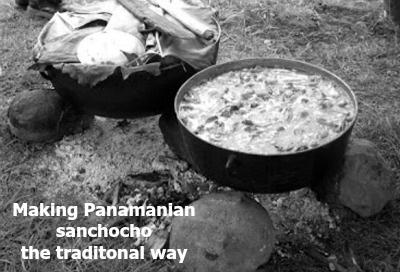
Serving Suggestions
To eat it the Panamanian way, serve it along with white rice on the side. You can either mix the rice into the soup or take a bite with each spoonful. It doesn’t matter, they do both.
Sometimes the soup is accompanied by patacones (fried plantains) as well.
The soup’s ingredients may vary , but almost all of Panama's Sancocho varieties share one characteristic: they are rarely spicy. Typically, Panamanians aren’t fond of spicy foods.